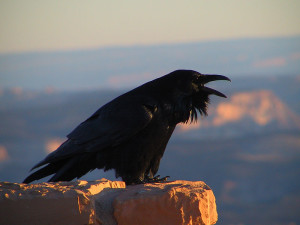Common vs. Chihuahuan Ravens

Every once in a while, somebody will put together a list of underappreciated identification challenges among North American birds. Common and Chihuahuan Ravens always make the list.
Here in Colorado, we have lots of ravens. Conventional wisdom says the ones on the southeastern plains are Chihuahuans, and the rest are Commons. But not everyone accepts the conventional wisdom. Some believe that Chihuahuan Ravens are not only the default raven in the southeast, but also regular wanderers north to the Wyoming border. Others maintain that to find a real Chihuahuan Raven, you have to go south of Colorado altogether.
For a long time, I haven’t been sure what to believe. But I’ve been browsing my own audio collections and those online, and I’m starting to think that voice is actually a very good character — maybe the best field character — for separating these two species. I’m willing to be convinced otherwise, and I’m interested in hearing from anybody who has experience with these two birds. But at the moment, here’s what I think I know about the sounds.
Chihuahuan Raven
It seems to me that Chihuahuan Raven may actually have one of the most predictable (least variable) voices of any North American corvid. Its classic call is a harsh “caw” that is deeper and much more coarsely burry than most “caws” of American Crow. It is of medium pitch, slightly nasal, and barely upslurred. It actually has something of a quacking quality — reminiscent of the harsh-sounding quacks that female Mallards do when they’re agitated.
Once you start comparing multiple recordings, this call of Chihuahuan Raven starts to seem remarkably consistent rangewide and from bird to bird:
Occasionally a couple of the birds in these recordings switch to some similar but slightly higher-pitched calls. And females will also do the clucking gurgles that many female corvids do (you can hear some on my recording above from Chihuahua). Other than that, though, these six examples are all so similar that they could almost be from the same individual bird.
Common Raven
From one of the least variable North American corvids, we transition to one of the most variable.
I’ve seen a number of sources argue that Chihuahuan Raven averages higher-pitched than Common Raven. This is a really problematic statement. It’s true that if you hear any really low croaks, you can be sure they’re from a Common:
But if you hear any really high croaks, you know they’re also from a Common:
(The ravens in that Red Top Ranch recording, by the way, were flying in a loose flock of 5 over featureless shortgrass prairie in southeast Colorado — location, habitat, and behavior all suggesting Chihuahuan Raven. But the voice doesn’t seem to match.)
Common Raven runs the gamut of possible pitches and tone qualities, from far below Chihuahuan’s pitch range to far above it. Chihuahuan occupies a limited space in the middle. Not only are Commons variable, but they often change sounds while you’re listening to them, unlike Chihuahuans. I might go so far as to say that if you hear a group of ravens giving a whole bunch of different-sounding calls, you’re almost certainly listening to Commons:
Some recordings of Common Raven come pretty close to matching the typical call of Chihuahuan Raven, but exact matches seem to be rare. Interestingly, the most Chihuahuan-sounding Commons I’ve found are mostly from California:
You may recall that over a decade ago, Common Ravens in California were found to be genetically distinct from other Common Raven populations — more closely related to Chihuahuan Ravens than to other Commons. So should we split Common Raven? Or reclassify California’s ravens as Chihuahuan?
Well, maybe not. The study found that Chihuahuan Raven and “California” Common Raven were still pretty distinct genetically. And more recent followup research has showed that “northern” Common Ravens and “California” Common Ravens have apparently been interbreeding extensively in western North America for a very long time, and the genetic differences between them may be decreasing over time. You could make a case for lumping ALL of North America’s ravens into one species, but I’m not sure that’s warranted, especially if Chihuahuans and Commons are not regularly interbreeding. More studies will need to be done on that.
On the whole, I could be underestimating the vocal variation in Chihuahuan Raven. And maybe there’s a lot of interbreeding going on in places like southeast Colorado. But at the moment, it really looks to me like Chihuahuan is a very predictable-sounding bird. And if it is, then vocalizations may be the single best way to identify one in the field.